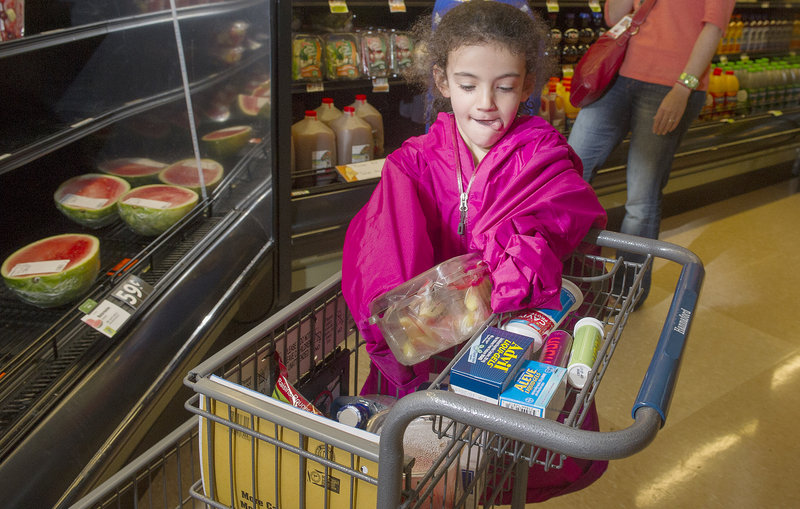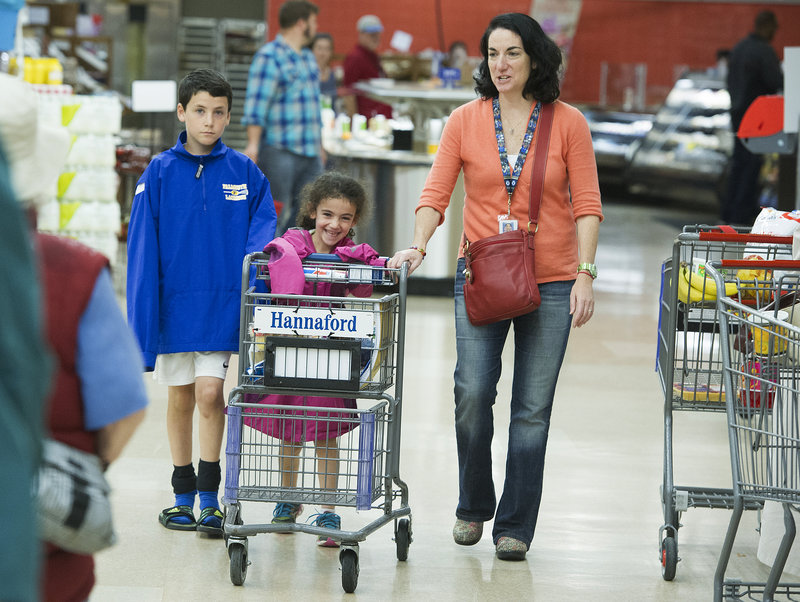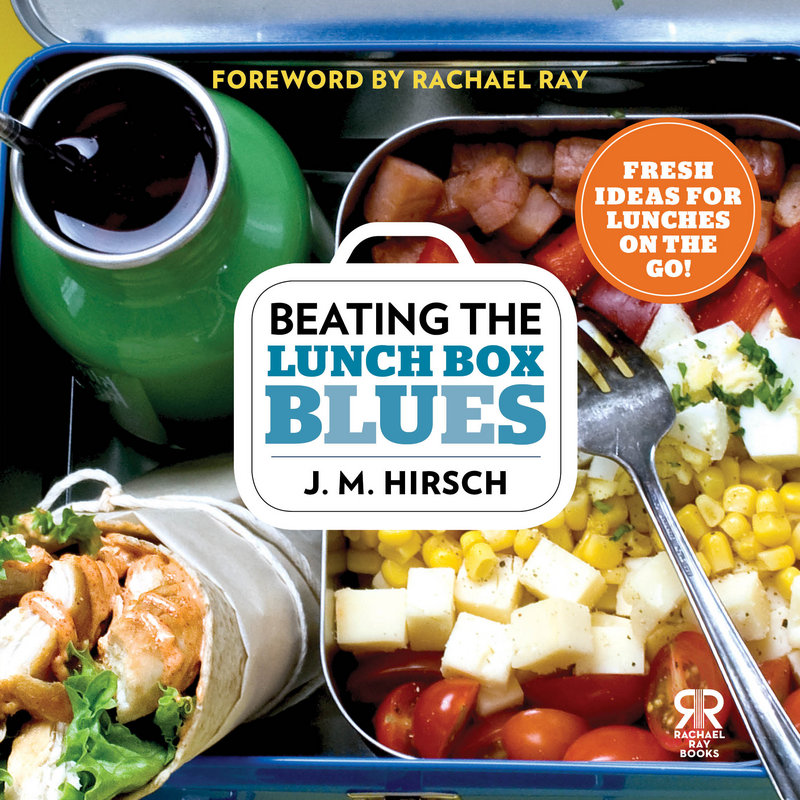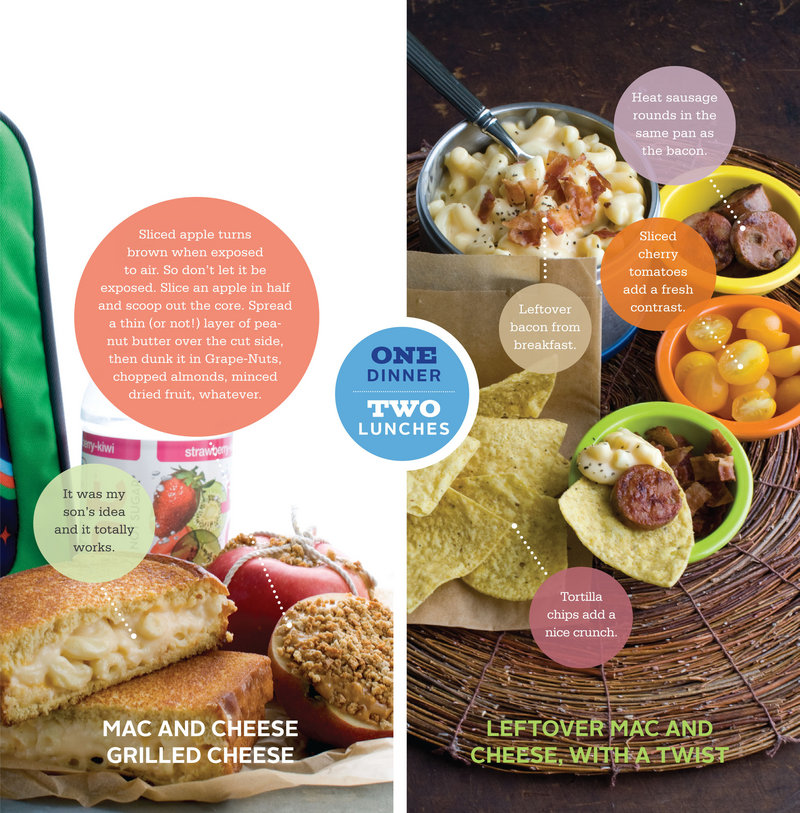PORTLAND — Soon-to-be second grader Emma King, 7, was grocery shopping with her mom at Hannaford on Friday when she paused to answer a few questions about school lunch. She is, after all, an expert.
Asked what she likes to see most in her lunch box, she replied: “Well, I’m always hoping for a Milano cookie as a treat. But I don’t really find them.”
But she gets those sometimes? “Well they’re rare.”
That’s just the way her mother, Catherine King of Portland, likes it. On most days, she tries to fill her children’s lunch boxes with three servings of fruits and vegetables.
“Then a sandwich as a protein, and something fun and snacky that I know they like eating, like Goldfish or Cheddar Bunnies or pretzels,” said King, who is Sen. Angus King’s daughter-in-law.
Potato chips and granola bars are no-nos.
But King says it’s hard sometimes to find new, creative ideas for school lunches that Emma and her brother, 5-year-old Gus, will eat.
Julie Greene, who was also shopping with her two children that day, agreed, even though as Hannaford’s “manager of healthy living,” she’s already a step ahead of everyone else when it comes to packing a fun-but-nutritious school lunch.
It’s tough, Greene says, because no matter how hard she tries to put together a healthy lunch for her 10-year-old son Ben, who will be a fifth grader this fall, sometimes he comes home and has traded his fruit leather for cheese puffs.
“It’s frustrating, but I think you just have to be realistic about it and realize that there are some things you can control and some things you can’t,” Greene said. “If you involve them in the decisions about what they want to eat, they’re much more likely to eat it.”
Lynn Fredericks, founder of FamilyCook Productions and co-author with Mercedes Sanchez of “Get Your Family Eating Right,” (Fair Winds Press, $21.99), says a healthy school lunch starts with building a foundation of healthy eating at home. If your child sees you drinking sugar-laden teas and sodas, or treating yourself to a cookie every day, it’s going to be hard to convince them they should have a piece of fruit instead.
“Every decision we make about food, we’re giving them messages every day,” Fredericks said.
Take your children with you to the farmers market and let them pick out the vegetables they want to try, she suggested. Your children will see how foods change with the seasons, and will begin to value “real” foods in a society that values convenience over healthy choices.
“American families are struggling to provide a healthy diet in their own homes,” Fredericks writes in her new book. “Working harder and longer hours is rewarded, over-scheduling children is encouraged. Mealtimes are outsourced to corporations and chefs, leaving parents on a constant search for a five-minute healthy recipe before succumbing to takeout, fast food or a packaged solution. Our children are rushed through school lunch in less than 15 minutes. Who can appreciate and value food in such a society?”
James Tranchemontagne, chef/owner of The Frog and Turtle in Westbrook and father of 8-year-old Logan, volunteers with organizations that are working to end hunger and helps teach families how to prepare healthier meals. He agrees that setting a good example at home will pay off in the school cafeteria. Set down the smart phones for an hour, disconnect from everyday life and cook and eat dinner with your children, he advises.
“Kids are kids,” Tranchemontagne said. “You’re not going to eliminate all the bartering and sharing at the (school lunch) tables. You’re not going to eliminate all junk food from their life. I mean, we all were there. But it is extremely important for kids to see parents cooking and sitting down at the table, having dinner together.”
I asked these and other experts (who are also parents) to offer advice on how to prepare a school lunch that you can feel good about and that a child will actually eat. They range from the moms shopping at the grocery store to local chefs such as Steve Corry, father of 6-year-old Seamus and 4-year-old Finnigan. Food writer J.M. Hirsch, food editor for The Associated Press and father of 8-year-old Parker, has a new book, “Beating the Lunchbox Blues” (Rachael Ray Books, $18), which is loaded with excellent suggestions for creating great school lunches.
Here are some of their suggestions:
• When you want to introduce a new food to your child’s lunch box, try it out at your own kitchen table first.
“You can’t hope that he’s going to want to eat a ham and cheese sandwich when he’s a peanut butter and jelly kid, put it in his lunch box and send it to school,” Tranchemontagne said. “That sandwich is either going to get traded, or it’s coming back home.”
• Pay attention to packaging. It’s one of the reasons Lunchables and similar products are so popular. Buy a bento box-style lunch box and fill it with a lot of little ingredients — a few grapes, a piece of cheese, some leftover meat.
“You don’t have to put a lot of effort into filling them,” Hirsch said. “But filling them with different things keeps it interesting for kids. They’d like to have lots of little choices rather than one big lunch.”
• Children also like to assemble things, another tendency that makes Lunchables so attractive to them. So fill that bento box with whole grain crackers, quality cheeses, meats, fruits and veggies, and let them go to town assembling it any way they want.
Tranchemontagne puts all the ingredients for “ants on a log” — a celery stick filled with cream cheese or peanut butter, and topped with raisins or other dried fruit — into his son’s lunch.
“It’s cool when he gets to (assemble) it in front of all his friends at the table,” Tranchemontagne said. “If he has the ants on a log, then everyone at the table wants one.”
• Let your child choose some fresh herbs or edible flowers at the grocery store or farmers market, or better yet, keep an herb garden at home, says Fredericks. Then let them experiment with different herbs on their sandwiches to see which ones they like best. Put some basil on a sandwich, or add some oregano to a vegetable dip. The child will be less likely to want to give his food away, and you’ll be helping to develop his palate.
• Ask your child to help you make a list of things she will be excited and happy to have in a packed lunch, Fredericks suggested. Show her what types of foods should be in a well-balanced meal. Be prepared to compromise. A child will say, of course, that she wants cookies every day. Agree to pack cookies once a week, with the understanding that the rest of the week she’ll be given fruit instead.
• If you value your time, don’t go overboard with the cutesy stuff. “A lot of the traffic online in terms of lunch ideas, it tends to be of the cutesy sort,” Hirsch noted. “You know, how do you shape your carrots into bunnies, and how do you mold cheese to look like mice, or carve radishes into rainbows? I’m like, wow, you people have so much time on your hands.”
A simpler way to coax a pre-schooler: Fredericks makes a vinaigrette with lemon juice and oil and tells them it’s “bunny juice.”
• Chef Steve Corry’s son Seamus found out some of his friends were buying lunch and wanted to try it too. But Corry and his wife Michelle didn’t want him buying lunch every day because they’d have less control over what he was eating. So they let him choose one day a week when he can buy lunch, and they go over the menu with him to help him make his choices.
• Corry would rather buy his applesauce and yogurt in bulk and package his sons’ servings himself in individual containers. But the kids turn their noses up at it; they prefer individual packs of apple sauce and those little squeeze tubes of yogurt. It’s more expensive to buy it that way, but Corry knows they’ll eat it.
“Those are, like, hot commodities that everybody’s after,” Corry said. “Even though it’s the same product, it’s the packaging. It’s really interesting to see it have that strong an effect at that age. The fact that it has Batman on it makes its value skyrocket.”
• Got leftover fish from last night’s dinner? Corry mixes leftover cod, salmon, hake or halibut with a little mayonnaise, Greek yogurt or hummus to make an alternative to tuna salad.
• Corry’s kids love cold pasta dishes, from homemade mac and cheese to angel hair pasta tossed with a little shrimp and garlic. They like just about any fruit, cheese, meat or grain. But vegetables? “Vegetables are still a no sale,” Corry said. “It’s so hard to sneak anything green by them.”
But they will eat vegetables if they come with some kind of dip — peanut butter, hummus etc. Why? Because kids love anything they can dip.
• To cut down on the sugar in juices, the Corrys dilute their sons’ juice with water. (Unlike 99 percent of other American kids, Seamus and Finn don’t like soda.)
• Corry isn’t sure why, but his sons love anything that still has a bone in it — a chicken leg, a duck leg brought home from the restaurant, a pork chop or lamb chop left over from dinner the night before. He’s not sure why, but it works.
• Hirsch isn’t sure why either, but he agrees that kids like “food on a stick,” and the stick doesn’t have to be a bone. He suggests buying a package of bamboo skewers and cutting a peanut butter and jelly sandwich into little squares. Thread them onto the skewers, interweaving pieces of fruit with the sandwich bites. Don’t forget to snip off the pointy tips with the kitchen shears “just so little Zorro doesn’t stab his lunchmates.”
• Don’t start poring through tons of recipes and cooking them just for your child’s lunch, Hirsch said. packing a good school lunch doesn’t have to be that difficult, or that costly.
“The most important rule to remember about lunches: Nobody, I don’t care who they are, nobody uses recipes to make lunch,” Hirsch said. “I work from home, and I am a food editor. I am the one person probably in the world who could use recipes to make lunch, and I have never done that in my life. It’s just not the way we operate in America.”
Hirsch does have recipes in his book, but they are for dinner for the whole family. The idea is to use the leftovers for school lunch. If you’re already boiling up some pasta or roasting a chicken dinner, for example, just throw in some extra pasta or roast a larger chicken so you’ll have some for the next day. One of Hirsch’s son’s favorite school lunches is leftover cooked chicken, pulled apart and tossed with barbecue sauce, served on a bun.
If you’re making a stir-fry for dinner, make a little extra rice. The next morning, after cooking a fried egg for breakfast, don’t wash out the pan. Throw in the leftover rice and heat it up with a little oil, then add any leftover vegetables or meats you have in the refrigerator. Voila — fried rice.
Last week, Hirsch took some leftover bacon, a single banana in danger of turning brown, whole wheat tortillas and peanut butter, and turned it all into Elvis-inspired sushi.
“I put the banana and the bacon in (the tortilla), I rolled it up, and I cut it into rounds of sushi-like bites of peanut butter, banana and bacon. And he loves it.”
• Get kids involved in planning their lunches. That starts at the grocery store. “Say, ‘OK, I’m going to be sending you a yogurt three days next week. What would you like as mix-ins? What would you like to bring to build your own parfaits with?’ ” Hirsch said. “Let them look around the grocery store to find things. If they choose chocolate and caramel sauce and candied cherries, well, you can veto that and say, ‘You can choose one unhealthy item, and then the other three items that you choose have to be healthy items.’ Now you’ve got something that they have designed, but you have controlled.”
• Design a lunch around a silly theme — all round foods, for example, which could include mini mozzarella balls, grapes, cherry tomatoes and anything else that shape you can think of. Or create a lunch of “mini foods” such as baby cucumbers, mini bagels or crackers, mini cheese rounds, and/or cherry tomatoes.
• It’s hard to go wrong with mac and cheese, and it’s not hard to make your own. Make extra pasta at dinner time. The next morning, dig out whatever cheese you have on hand along with some sort of creamy dairy base — Greek yogurt, sour cream or creme fraiche are good choices. Put it all in a saucepan, and two minutes later you have a creamy mac and cheese.
“I don’t get hung up on what type of cheese I use,” Hirsch said. “I use whatever I happen to have pieces of in the refrigerator. I don’t get hung up on the shape or size of the pasta. If all I have is linguine, I will use my kitchen shears to cut it into bites. And that’s three ingredients.”
Consider spiking it with a little hot sauce, which enhances the other flavors without adding a lot of heat, Hirsch said. Make a more robust version of the dish by adding leftover steak, chicken or pork, deli meat or leftover cooked vegetables.
• Involving children in planning sometimes means occasionally embracing their crazy ideas. Hirsch once made a whole wheat “grilled mac and cheese” for his son. And when Parker asked for chocolate pudding instead of yogurt in his yogurt parfait, Hirsch gave him yogurt topped with a teaspoon of mini chocolate chips. “I’ve probably added 20 calories with that teaspoon of chips,” Hirsch said. “He thinks it’s the greatest thing in the world.”
“You can usually find a way to give them some version of what they’re asking for that you can feel good about,” he said.
• Grow a garden, and let your child help. Greene’s daughter Anna, almost 7, loves fruits like strawberries, blueberries and raspberries, but her fondness for vegetables was lacking until her father helped her start a garden. Now she likes spinach. She also likes tomatoes and carrots — or, as she calls them, “cawwots.” (Anna names her carrots. Carroty, meet Carroty Jr.)
• Greene suggests looking for newer products such as sliced apples and single packs of blueberries in the produce section.
It’s not just junk food that’s being packaged for convenience these days.
• Treats are fine, as long as you stay in charge of what they are.
“We make cookies at home, and sometimes those end up in the lunch box,” Greene said. “Or brownies. I’ve learned how to bake with whole wheat pastry flour.”
Once a year, on the last day of school, Hirsch lets Parker fill his lunch box with whatever he wants, except soda. This year, the 8-year-old chose gummy candies, licorice, a cupcake, a cookie and a lemon bar. Hirsch said the boy came home “bubbling,” excited that all the older kids wanted his lunch.
The message? “We’re not going to have these things every day of your life,” Hirsch said. “But one day a year, go crazy.”
Interestingly, Parker’s end-of-year lunch box isn’t always filled with junk. One year, he chose smoked ham and golden raspberries — perhaps a sign that some of his father’s lessons about food are getting through to him.
“Food is important,” Hirsch said. “And the quality of the food that we feed ourselves and our children matters. Giving our families a diet of super-processed junk just isn’t a good choice. We talk to our children about making good choices. This is one of those times when parents have to make a good choice, and a diet of highly processed is just not a good choice.”
Staff Writer Meredith Goad can be contacted at 791-6332 or at mgoad@pressherald.com
Twitter: MeredithGoad
Copy the Story Link
Send questions/comments to the editors.







Success. Please wait for the page to reload. If the page does not reload within 5 seconds, please refresh the page.
Enter your email and password to access comments.
Hi, to comment on stories you must . This profile is in addition to your subscription and website login.
Already have a commenting profile? .
Invalid username/password.
Please check your email to confirm and complete your registration.
Only subscribers are eligible to post comments. Please subscribe or login first for digital access. Here’s why.
Use the form below to reset your password. When you've submitted your account email, we will send an email with a reset code.